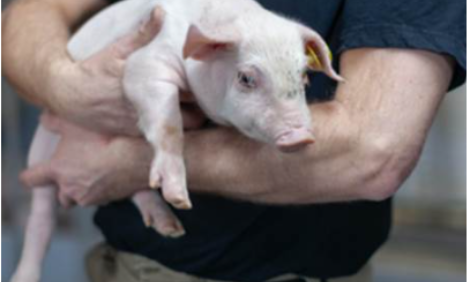



Starting Newly Weaned Pigs
By Ed Barrie - Swine Sow-Nursery Specialist/OMAFRA and published in October 2007 Pork News and Views. Starting newly weaned pigs on feed is a management intensive task.Of particular interest at this time of the year is the range in daytime to night time temperatures found across Ontario, and the knowledge that colder winter temperatures produce conditions which lead to reduced animal performance in many weaner barns. It is reasonable to check heat pads, fans and controllers and/or recorders to insure that they are working correctly now rather than after a room of new starts has been chilled, because of a failed controller. Hand held remote thermometers give a quick and immediate response on heat pads and can be used when either a room is being filled or is in operation. Sensors, fans, motors and recorders are all mechanical systems that can and do wear out, and are best replaced now if not operating correctly. Recording an event and scheduling replacement are far superior to trying to function without the unit or being forced to do an emergency repair at a difficult time and possibly being forced to use an incorrect replacement item in an emergency.
Water systems are another area where some inspection could be beneficial. Are the drinkers you are using getting the required amount of water to the animals in a method acceptable to the weaned pigs? Have you tried any new or different watering systems? The basics of multiple drinkers spread around the pen at shoulder height still apply. What is different is the addition of several bowl type drinkers to a pen, and the use of reduced pressure water nipple systems. We used to assume that water squirting out of a pig’s mouth when it bit on a drinker was a good thing. In fact this is an animal that has learned that a sucking action is necessary to get nutrition, but is now forced with a pressure delivery when it tries to suck. It often takes several days to adapt to the change. In this time its reduced liquid intake can often lead to reduced feed intake which slows its ability to grow. In addition, the water wasted immediately becomes a waste product and must be handled and stored as such.
Sanitation is another of the major issues facing the weaner barn manager. It is more important then ever and more difficult then ever to get facilities as clean as they need to be before each new batch of animals is moved in. This would be a good time to review your health status of the piglets coming in, to the health status of the weaned pigs leaving the facility with your veterinarian. Not only is the average daily gain and general health status of the animals leaving important, but the disease profile of the piglets both in and out of the facility is equally important. Do you have resident bacterial loads that are acceptable, a challenge to the animals, or sufficient challenge to cause death or disease to the incoming animals? As a routine management practice, disinfectant agents should be changed a minimum of twice a year. Newer technologies suggest that pressure washing with hot water is producing acceptable results for the wash program. The disinfection process, depending completely on the instructions of the manufacturer, should be carried out, insuring the correct volume of disinfectant is applied to the area being cleaned, and applied in a method that produces effective results. These methods include foam, direct spray application and misting. Maintaining the required follow up time and temperature requirements after disinfecting and before animals are reintroduced is very important in allowing the disinfectants time to destroy the bacterial load present. The problem that occurs is that no one disinfectant product destroys the whole range of microbial and viral agents that may be present and affect the health of piglets in a weaner facility. The organisms that are not controlled tend to build up in numbers and create a serious challenge to new animals. By changing disinfectant products regularly you have a greater chance of removing more of the organisms present that may affect piglet health. In locations where serious problems persist, veterinarians could take swabs and grow out samples to be able to identify the organisms present and make more accurate recommendations on disinfectant products.
Now, having said all this it is quite realistic to expect that you have heard it all before. The question then becomes, have you read all the labels on everything you use, have you searched for better or other ways of achieving animal performance, and thirdly and most importantly do you have good records of what your style of management has produced in animal performance, doing things the way you have in the past?








